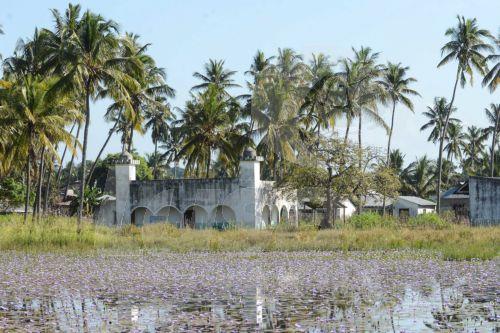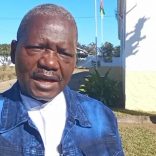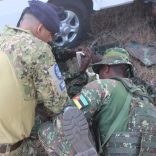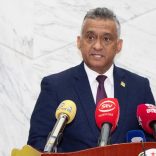Communication on focus in the Train-the-Trainers Programme - European Union Military Assistance ...
Deals and quarrels between mosques preceded bloody day in Mozambique

Photo: Lusa
Salimo Chingu, aged 52 and traditional leader of Monjane, shows Lusa the places in the village where the bodies of five residents were found on one of the bloodiest nights of violence in isolated locations of Cabo Delgado, northern Mozambique.
In an action attributed to a group of alleged Islamic inspiration suspected of being behind the other attacks on remote villages in the province of Cabo Delgado which have been taking place since October 2017 and the initial two-day siege of the village of Mocímboa da Praia that resulted in the invasion of police stations and the murder of two officers, a further ten people were murdered on May 27, some by beheading, in Nangamede and Monjane.
Raids since the last Sunday of May have already accounted for between 35 and 40 dead, according to official information.
When the group armed with machetes and firearms arrived, they began to loot “houses and ‘barracas’ [stalls]”, Salimo recounts with the help of Momade, one of the few Portuguese-speaking residents.
By moonlight, they went inside, taking food and valuables. Anybody who resisted or failed to flee ended up dead, like the first local secretary of the Mozambican Liberation Front (Frelimo), shot dead in his backyard – of the five casualties, and the only one with a prominent position in the community.
Salimo, Momade and the small crowd that surrounds them in the centre of the village fell silent when questioned about the origin of these aggressors.
Nassurulahe Dulá and Saide Bacar, two Muslim leaders interviewed by Lusa in Pemba and Montepuez respectively in the last eight months, blame foreign religious leaders who have opened mosques in Mozambique since 2104 preaching a brand of Islam opposed to that which has been the tradition in Mozambique, and denying the power of the state and imposing a sharia law.
They limit the freedom of women and children, who leave formal schooling, and promote armed violence for obscure purposes, residents say.
“We have tried many times to oppose these groups,” warning that “no one should join them”, but their grooming of recruits produces results, especially in areas where poor people with little schooling live, Dulá points out.
On repeated questioning, Salimo recalls that one of these leaders tried to open a mosque in Monjane for some time, but failed because the local people opposed the practice of his new religious customs.
This same person, or one of his associates, was arrested a few days ago by the authorities, after his property escaped the attack on the village unharmed, although it was among the richest, which led to the mistrust of the population, he adds.
A Muslim worker from Olumbe in Palma, location of one of the affected districts and a village near those attacked, says support was a bargaining chip.
In his Mwani ethnic group, one of those predominant in the region, he learned of businesses financed by new Islamic leaders who in return demanded attendance at the mosques they were opening.
“They said that if we prayed in this new mosque, we would get money to do business. That we will help,” he tells Lusa.
But not everyone who has obtained funding for a new fishing boat or truck will have agreed to take orders later, he adds.
The day after the initial attack on Mocímboa da Praia by a group of about 30 men who were members of the new mosque there, another of the new mosques, this time in Olumbe “was destroyed by the people who built it”, he said.
“They prayed there” and the fact that they demolished it after the insurrection in Mocímboa, some tens of kilometres to the south, led the population to conclude that “they belonged to the same group” that disappeared in the woods, covering their tracks and connections. Nobody knows “who the boss is”, or what orders he gave.
João Pereira, Salvador Forquilha and Saide Habibe, authors of the study “Islamic Radicalisation in the North of Mozambique” presented in Maputo in May, report that the money to attract members comes from illicit trafficking in wood, rubies, ivory and coal in Cabo Delgado.
Networks in which “the leaders of the group are involved”, networks that also feed other structures abroad, “for example militia commands in the Congo, Somalia, Kenya and Tanzania”, in a dynamic that can also be used to buy weapons, Pereira says.
The researcher adds that protecting these illicit business will be one of the group’s main goals, which, furthermore, does not have “a well-crafted doctrine”, though it justifies its emergence with the fact that local communities “do not practice Islam as laid down by the prophet”.
To date, no leader has yet emerged, nor have there been any claims after any of the attacks that help clarify the aims of the violence.
An article published in April by the Geneva-based Global Initiative adds that trafficking in heroin from South Asia to Europe and Southern Africa passes through Cabo Delgado, and the attacks may be a reflection of moves to control these routes.
The first references to the group appear as Ahlu Sunnah Wa-Jamâ, “adherents of the prophetic tradition and tradition” with Mwani leaders linked to religious, commercial and military circles of radical Islamist groups in Tanzania, Somalia, Kenya, and the Great Lakes region, according to the study released in May.
The group becomes visible as a religious movement mostly made up of Islamic youths from Mocímboa da Praia and surrounding districts, and the population beginning to call it ‘Al-Shabaab’ (meaning youth, in Arabic) in an allusion to their ideas and appearance.
It is admitted that the social basis is living in degrading social conditions and feeling political exclusion, especially among the Mwani in relation to the Maconde ethnic group, and by the lack of a welcome in local mosques for those who were born outside the country, among other reasons.
At the end of 2015, the group formed military cells, led by 30 to 40 people who had been sent to the Great Lakes region to receive training by militias whose chiefs were hired by the Al-Shabaab network in Tanzania, Kenya and Somalia, the research reads.
Cesário da Silva, head of a village on the outskirts of Montepuez, told Lusa after the attack on Mocímboa that in the previous year, 30 people from the community, including couples with children, had moved to hidden camps in the woods.
“There are people who have fled there and told us what is going on. They went to join the group, but when they arrived they did not find religion, only trafficking and killings,” Sheik Saide Bacar told Lusa .
On May 6, Mozambican police announced that they had found, in Nangade near the border with Tanzania, three female fugitives from the hideout of one of the armed cells that had attacked the villages.
But what the forest still hides continues to be a challenge, even for the authorities.
Mozambique police have announced since the May 27 killings that the attacks are now being carried out by smaller number of adherents trying to survive, claiming that the main group has been dismembered by the authorities with hundreds of people already in custody since October 2017.
“This is a group that has been widely fragmented,” and the latest crimes represent “a desperate attempt to get some purchase”, police spokesperson Inacio Dina, contradicting the idea that this escalation of violence means an increase in the threat to the security of Cabo Delgado.
Despite the arrests, there have been no clarifications, apart from the release by security forces in December of the names of two Mozambicans, Nuro Adremane and Jafar Alawi, as alleged organisers of the initial attack on Mocímboa da Praia after studying religious doctrines and receiving military training in Tanzania, Sudan and Saudi Arabia and now of unknown whereabouts.
The attacks come at a time when work involving some of the world’s major oil companies is underway to exploit natural gas in Cabo Delgado, with production both offshore and onshore expected to start in four to six years.
The wave of violence has not affected the construction of the gas liquefaction plant and associated structures in the Afungi peninsula in Palma – an investment that involves Andarko and Eni, among other international firms.
After the initial siege of Mocímboa da Praia, the attacks have moved away from the asphalt, the electricity and infrastructure.
Part of the answer about the nature of the threat is hidden somewhere in the forest in northern Mozambique. Another part lies in neighbouring countries like Tanzania, with which, given the proximity of the border, a strong connection is visible in everyday life there, while Maputo lies almost two thousand kilometres to the south.











Leave a Reply
Be the First to Comment!
You must be logged in to post a comment.
You must be logged in to post a comment.